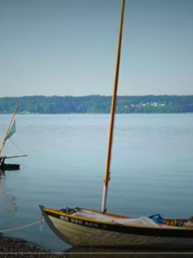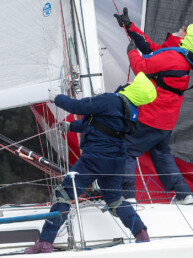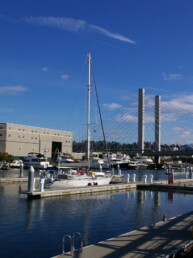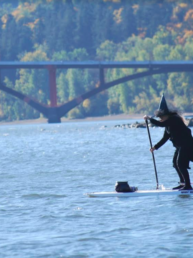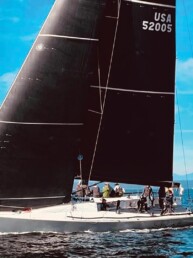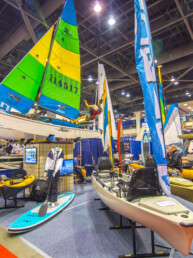This is the third in Andy Cross’s excellent series about winter cruising destinations around the Puget Sound region. If you missed the others, be sure to check them out: Winter Anchorages of Puget Sound and Holiday Splendor in the San Juan and Gulf Islands.
Quiet Nights at Destination Docks
Faint shafts of dull morning light filter through the port above my head, nudging me awake. My eyes slowly blink open and I lay for a moment taking in the scene. Not a hint of winter wind sings in the rigging and the boat is eerily—almost impossibly—still.
Climbing out of my bunk, I work quickly to the companionway hatch and in a sort of double motion, slide it open while also pulling a hoodie over my head. A crisp air hits my face, and when my eyes focus, it’s brighter outside than I expect. SNOW! Everywhere.
I gaze quickly from Yahtzee’s cockpit to the typically brown wooden docks and then down to where a vibrant green lawn stood just 12 hours earlier. Everything is cloaked in puffy pillows of white. Overnight, Blake Island has turned from a verdant forest hideaway to a winter wonderland piled with snow.
After an impromptu snowball fight on the foredeck with our sons—Porter and Magnus—and a tromp through the woods, we carefully make our way off the dock and point Yahtzee’s bow south down Colvos Passage towards Gig Harbor. Just a whisper of wind greets us along the way, but the snow continues to fly. By the time we squeeze in through the harbor’s narrow entrance and make for the public dock, the air temperature is warm enough that the once thick frosty blanket melts rapidly. Within hours, the sun is out and it’s almost as though the snow never even happened.
Such is life for the winter cruiser upon the Salish Sea.
While cruising Puget Sound and the San Juan and Gulf islands for three consecutive winters without a permanent slip, our family reveled in this season’s uncertainties. All the while, we got particularly good at bouncing from port to port, dock to dock, anchorage to anchorage with a style that made the most of short days, empty spaces, and welcoming locales.
In part three of my series on winter cruising, I offer some tips on our favorite places to tie up, other than conventional marinas (though we love those too), and some of the best of these happen to be Washington State Park docks.
Take Advantage of Washington’s Marine State Parks
The numerous marine state parks that dot Puget Sound and the San Juan Islands are a truly exceptional and distinctive feature of cruising the Pacific Northwest. And while many of the state park docks are removed for the winter months, there are several left in place and maintained for boaters to use year ‘round. In part two of this series, I wrote about staying on the dock at Prevost Harbor on Stuart Island, and on the other side of the island the floats at Reid Harbor are available for use in the winter as well. Also, one dock in Fossil Bay on Sucia Island remains in place for winter visitors.
Whether you only cruise to these parks in the summer or are an all-season mariner, I highly encourage everyone to buy a state parks Moorage Permit. If you plan to moor at docks, floats, and buoys in these fee areas multiple nights a year, you will likely save money by purchasing the annual permit, which is valid January 1 through December 31. One thing to keep in mind, however, is that all boats over 45 feet are not allowed to moor on buoys, only on docks and at linear moorage. The permit is $5 per foot per year ($60 minimum). Without a permit, overnight dock moorage is 70 cents per foot ($15 minimum) and overnight buoy moorage is $15. Here are three of our favorite marine state parks to visit in the winter.
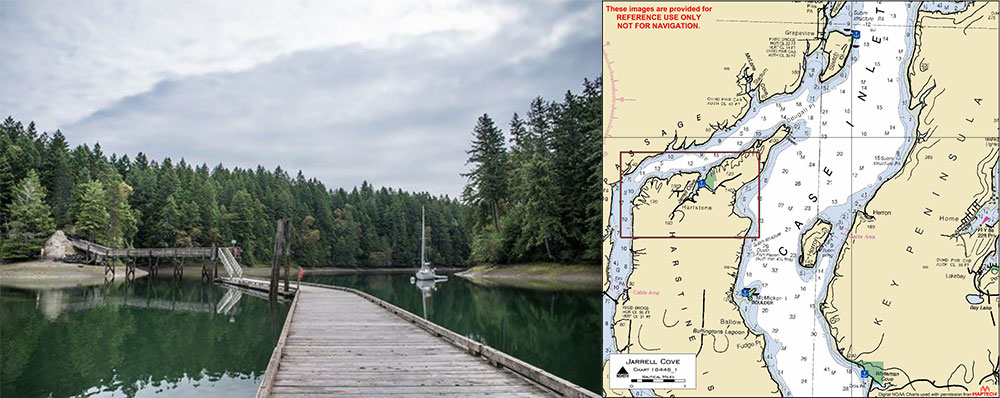
Jarrell Cove Hidey-hole
Case Inlet was whipped into a frenzy from a strong southerly breeze as we sailed north up the east side of Harstine Island towards Jarrell Cove. Having visited the cove before, I knew it would offer perfect protection from the winter wind and allow for a couple peaceful days for our crew to relax before working our way back north up Puget Sound.
Turning into the cover from Pickering Passage, we found the little bay virtually empty and the breeze considerably calmer on this late February weekend. Accordingly, we had our choice of spots on the park dock and deployed our fenders while passing the mooring balls that line the middle of the cove. With Yahtzee set, our crew set off to register and take a walk through the tall trees that line the park.
Visiting Jarrell Cove State Park was aptly described by one visitor (according to Washington State Parks) as, “a sensory extravaganza, with a chorus of bird calls, saltwater and conifer smells, dense tree stands and opal-colored water all around. Whether you’re there for the peace or the sociability, a day or a weekend at Jarrell Cove will put a smile on your face long after you’re back to the grind.” Having visited the cove in both winter and summer, the narrative definitely rings true.
Jarrell Cove State Park is a 67-acre, marine camping park with 3,500 feet of shoreline in the South Sound with 14 mooring buoys and 650 feet of dock space. Jarrell’s Cove Marina is across from the park and has a small store and 200 feet of transient space if the park is full. If you’re looking for a truly serene winter cruising experience, this is it.
Take a Blake-ation
Well known to Puget Sound boaters, Blake Island is a gem right smack in the middle of the sound and is an excellent place to visit when the days are short and a bit cold. With its close proximity to Seattle, the marine state park—which covers the entire island—is a welcoming spot for boaters and campers anytime of year, but we particularly love it in the quiet winter months. Twenty-four mooring buoys and numerous campsites surround the island, and the marina’s 1,500-feet of moorage with power hookups can accommodate quite a few boats. We’ve spent numerous winter nights here when Yahtzee has been the only boat in the marina.
During one late February Blake-ation, frost covered the ground when we started out on the island’s 3.5 mile loop trail until bright sunshine burst through the towering treetops to warm up the day, burn off the ice, and have us shedding layers as we went. The trail reveals beauty at every turn and it always feels great to get out meandering its varied terrain and offshoot beaches. When we’re not hiking the trails or combing the beaches, our other Blake Island favorite is to grab one of the shelters to make a fire and cook dinner and roast s’mores. It’s always amazing to stand there in the glowing light and look at our boat sitting in the little marina then across the sound to the city of Seattle—such a contrast!

Serenity at Deception Pass
Swirling whirlpools looped around and underneath Yahtzee as we were swiftly carried eastward with a flood tide towards Deception Pass. With mouths agape, our crew sat in the cockpit looking in awe at both sides of this incredibly carved pass. In the moment, it was easy to see why Deception Pass State Park is the most heavily used state park in Puget Sound. It’s stunning.
Once through the pass, we made for the dock at Cornet Bay and found only a lone boat occupying the park float. There are also two 100-foot detached floats that are set parallel to the main float; both sat empty. Though the park is known for heavy use, we hit it right on a cold couple days in late December. Bundled up and with hot cups of coffee in hand, we set out to walk the trails and beaches that stretch east from the park dock. Not knowing much about this part of the park, we were pleasantly surprised by the beautiful walk east to Hoypus Point, where we found concrete ruins that are the remnants of the old Fidalgo Island ferry dock.
We lazed away a couple days exploring various portions of the park and, though it is obviously bustling in the summer months, we were happy to find Cornet Bay to be a slice of winter serenity.
Public Docks
Besides marine state park docks, there are several other alternatives around the sound for inexpensive and unique moorage. The first is to use public docks in Gig Harbor and Eagle Harbor.
Gig Harbor’s Jerisich Dock is named for early settler Samuel Jerisich, and is located adjacent to Skansie Brother’s Park in the heart of town. The dock provides transient moorage for boaters and features a pump-out station, water, restrooms and power (water and pump-out may be restricted during cold spells). Boats are required to pay an overnight moorage fee that is 50-cents per foot (minimum charge of $10 per night) in the winter and $1 per foot (minimum charge of $20 per night) from the Friday before Memorial Day through Labor Day.
At Eagle Harbor on Bainbridge Island, Waterfront Park features a 900-foot city dock that is open year-round and is first-come, first-served. The dock has moorage for vessels up to 70 feet and is 50-cents per foot for an overnight stay. Water and electrical hookups are an extra $5 per day. We love this dock for its close proximity to the park and playground, groceries, restaurants, pubs, and a variety of other businesses.
Yacht Club Reciprocity
In addition to park and public docks, we’re huge fans of having a yacht club membership, with a big perk being the use of reciprocal moorage. While some boaters turn their noses up at the thought of joining a yacht club, the stigma of stuffy clubs is misguided. There are dozens of welcoming and accommodating yacht clubs around the Salish Sea that range from small to large with a variety of activities and amenities included. And if cost is an issue, there are a handful of clubs with reciprocal privileges that are fairly inexpensive. Not only does reciprocal moorage allow you to utilize other clubs’ docks and facilities at a reduced (or complementary) rate, but it is also an excellent way to meet members of other clubs—certainly a win-win!
Our favorite reciprocal docks around the region include Poulsbo Yacht Club, Swinomish Yacht Club, Olympia Yacht Club, Anacortes Yacht Club, Orcas Island Yacht Club, and Kingston Yacht Club, to name a few.
Get Out There
While anchoring out can deliver the solitude many cruisers thirst for, many of the busiest dock-destinations around the Puget Sound provide a surprising amount of solitude, a little extra protection and comfort, and some on-shore intrigue during the winter months.
Fortunately, whether you choose to sail near or far from your home harbor during the winter, you won’t be lacking in places to stop. That’s one of the things that makes cruising the greater Puget Sound area so appealing this time of year. The seasonal availability and accessibility of the many docks, marinas, anchorages, moorings, and ports from Olympia to the San Juan Islands—and beyond—truly offers a choose-your-own-adventure experience.
Though not without its challenges, “off-season” cruising at anchor, tied to the dock, or underway is something we can’t recommend highly enough. For our family, these voyages have been overwhelmingly positive and we hope this three-part series makes you want to set out and chart your own winter escapades.
Andy Cross
Andy Cross is the editor of 48° North. After years cruising the Pacific Northwest and Alaska with his family aboard their Grand Soleil 39, Yahtzee, they sailed south and are currently in the Caribbean Sea. You can follow their adventures at SailingYahtzee.com.

